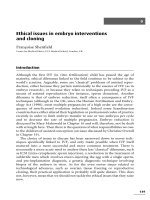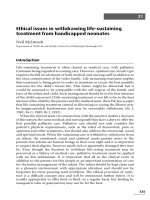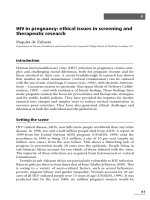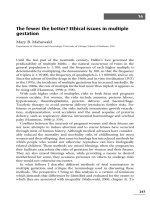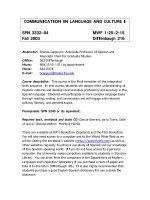Slide Issues in language testing
Bạn đang xem bản rút gọn của tài liệu. Xem và tải ngay bản đầy đủ của tài liệu tại đây (1.13 MB, 55 trang )
Issues in language
testing
Group 7 – K18C:
Nguyen Thi Bich Ngoc (12.08)
Do Thu Phuong
Do T Phuong Thanh
Tran Thi Thu Trang (30.03)
Tran Thi Thu Trang (18.10)
Tran Thi Thu Hien
Nguyen Thi Nhai
Le Thi Nhung
Nguyen Thi Thanh Tam
Nguyen Thi Thanh
Le Huong Thao
Ngo Thi Thom
1
2
AN INTRODUCTION TO LANGUAGE TESTING
1.1 Testing and Teaching
1.2 Why Test?
1.3. Types of Test
DIFFERENT APPROACHES TO LANGUAGE TESTING
2.1 The essay-translation approach
2.2 The structuralist approach
2.3 The integrative approach
2.4 The communicative approach
3
PRACTICAL ASPECTS OF DESIGNING A LANGUAGE TEST
3.1 Quality of a good test
3.2 Stages of designing a language test
1. AN INTRODUCTION TO LANGUAGE
TESTING
1.1. TESTING AND TEACHING
“ A test is a method of measuring a person’s ability or
knowledge in a given domain”
(Brown, D.H.2001. Teaching by principles. Long man)
Testing
is when you want to know how much someone knows
by asking questions.
(Long man's Active Study Dictionary )
Teaching is when you teach someone something, you give
them instructions so they know about it or how to do it; You
make them think, feel or act in a new or different way; You
explain or show students how to do something.
(Collins' COBUILD Dictionary )
1.1. TESTING AND TEACHING
TESTING
TEACHING
Closely
interrelated
The teaching
may determine the test =>
Tests = devices to reinforce learning and to
motive students
The test decides the teaching => Tests = a
means of assessing students’ performance
1.1. TESTING AND TEACHING
Mechanical
test of
structure
Communicati
ve test of
language
Tests of
grammar,
translation or
language
manipulation
A focus for
purposeful
everyday
communication
Negative and
even harmful
effect on
teaching
- Much more
positive effects
on learning
and teaching
- Improved
learning
habits.
1.2. WHY TEST?
*Evaluate
students’
performan
ce for
purpose of
compariso
n and
selection
*Increase
*Diagnose
teachers’
the
own
student’s
effectivene
ss =>
Students
benefit
more
weaknesse
s and
difficulties
=> Render
assistance
*Evaluate
the
effectiven
ess of the
syllabus as
well as the
methods
and
materials
being used
*Motiva
te
students
1.3. TYPES OF TESTS
1.3.1 Achievement/ Attainment
tests
1.3.2 Proficiency tests
1.3.3 Placement tests
1.3.4 Aptitude tests
1.3.1 Achievement/
Attainment test
Formal tests designed to show
mastery of a particular syllabus or corpus
of language.
2
kinds
CLASS
PROGRESS
TESTS
STANDARDISE
D
ACHIEVEMENT
TESTS
CLASS PROGRESS TESTS
measure how well learners have
mastered the material [or skills]
taught in class and [or] how well they
have improved in a given area.
-Constructed by the class’s teacher.
- Based on the language program which the class
has been following
-Each test situation is unique.
-It is as important as an assessment of the
teacher’s
learning.
own
work
as
the
student’s
own
CLASS PROGRESS TESTS
•A good progress test should:
+ Encourage sts’s performance and
confidence
+ Aim to stimulate learning and to reinforce
what has been taught.
+ Allows the sts show what they have
mastered.
STANDARDISED ACHIEVEMENT
TESTS
Far more formal tests and are
intended to measure achievement
on a larger scale.
E.g.: University/ college/ school
entrance exam; school certificate
examination; annual school examinations.
-The constructers of such tests rarely teach
any of the students being tested.
- The test is often based on a published
syllabus
- It exerts a strong influence on the teaching
in schools
STANDARDISED ACHIEVEMENT
TESTS
A good achievement test
should reflect the particular
approach to learning and teaching
that has previously been adopted
1.3.2 Proficiency
tests
Proficiency
Tests are not usually based
on a particular syllabus but are used to
measure achievement in relation to a
specific task that the candidates may be
required to perform at a subsequent
point of time.
‘Proficient’ = having sufficient
command of the language for a
particular purpose.
Other proficiency tests do not have
any occupation or course of study in
mind
Function: to show whether candidates
1.3.3 Placement
tests
Placement tests
-used to place students at
appropriate level of instruction
within a program.
- used to assign students to classes
at different levels.
The most successful placement
tests are those constructed for
particular situations
1.3.4 Aptitude
tests
- used to measure capacity for
learning a language.
The most common aptitude tests
set tasks that are related to the
linguistic skills possessed by a good
language learner [such as the ability to
perceive sound and spelling correspondences
and the ability to identify patterns in language].
1.3.5 Diagnostic
tests
Diagnostic Tests enable teachers to
identify any areas of weakness or
difficulty, so that they can then plan
and implement an appropriate
remedial teaching program.
They may be used to assess the
knowledge and skills of learners in
particular aspects of language before
the start of a course [and consequently may
be used for placement as well as course design
purposes].
2.1 The essay-translation approach
2.2 The structuralist approach
2.3 The integrative approach
2. 4 The communicative approach
2.1 The essay-translation approach
- It is commonly referred to as the pre-scientific
stage of language testing.
- Tests usually consists of essay writing,
translation and grammatical analysis.
- The tests also have a heavy literary and
cultural bias.
2.2 The structuralist approach
- Language learning is chiefly concerned with
the systematic acquisition of a set of habits.
- It draws on the importance of contrastive
analysis and the need to identify and measure
the learner’s mastery of the separate elements
of the target language. The skills are also
separated.
2.3 The integrative approach
- This approach involves the testing of
language in context.
- Tests are designed to assess the learner’s
ability to use two or more skills
simultaneously.
- They are best characterized by the use of cloze
testing and of dictation. (Oral interviews,
translation and essay writing are also
included)
2.3 The integrative approach
Cloze tests
- They measure the reader’s
ability to decode ‘interrupted’
or ‘mutilated’ messages by
making the most acceptable
substitutions from all the
contextual clues available.
(example)
- Texts neutral in both
content and language should
be used.
- Cloze testing is a good
indicator of general linguistic
ability.
Tests of dictation
- The integrated skills
involved are auditory
discrimination, the auditory
memory span, spelling, the
recognition of sound
segments, a familiarity with
the grammatical and lexical
patterning of the language,
and overall textual
comprehension.
- Teachers should dictate
in meaningful units of
sufficient length. (example)
2.4 The communicative approach
- Communicative tests are concerned primarily with how language is used
-
in communication.
Success is judged in terms of the effectiveness of the communication.
Communicative testing results in an attempt to obtain different profiles of
a learner’s performance in the language.
They must reflect the culture of a particular country.
The most important criterion for communicative tests is they should be
based on precise and detailed specifications of the needs of the learners.
Qualitative modes of assessment in preference to quantitative ones should
be used. (example)
PRACTICAL ASPECTS OF DESIGNING A
LANGUAGE TEST
1. Qualities of a good test
1.1. Reliability
1.2. Validity
1.3. Practicality
2. Stages of test construction
2.1. Writing test specification
2.2. Writing the test
2.3. Piloting the test/ Pretesting
3. Washback
QUALITIES OF A GOOD TEST
1.1. Reliability
1.2. Validity
1.3. Practicality
1.1. RELIABILITY
1.1.1. A Definition of Reliability
1.1.2. Factors that influence the reliability of a test
1.1.2.1. Size
1.1.3.2. Test Item Level of Difficulty
1.1.4.3. Marking
1.1.5.4. Syllabus
1.1.3. How to make tests more reliable

